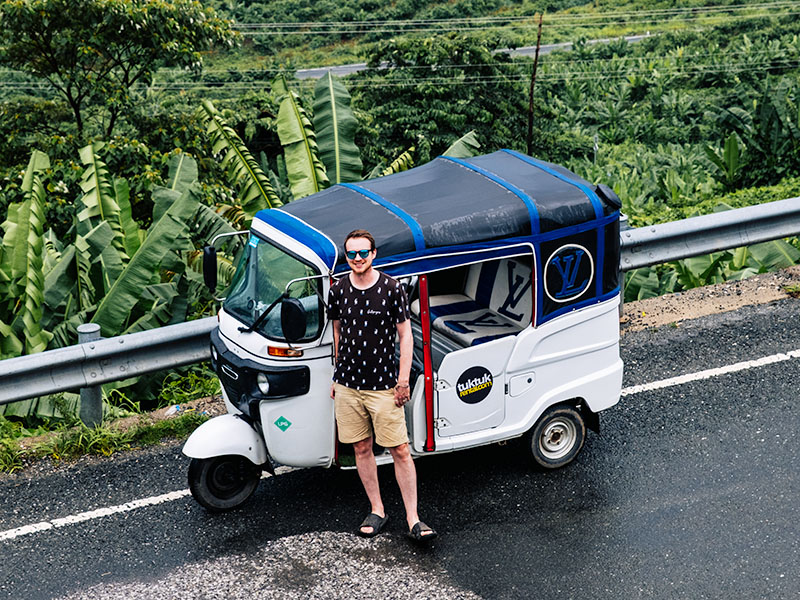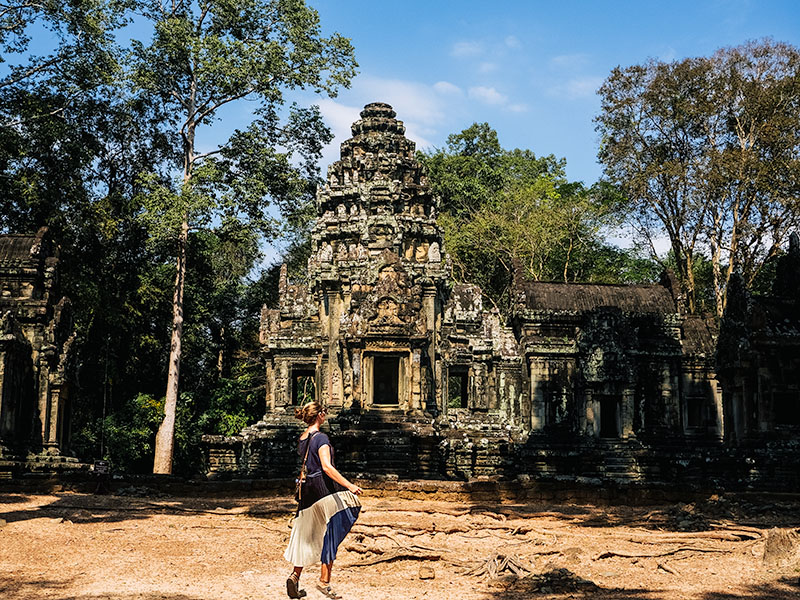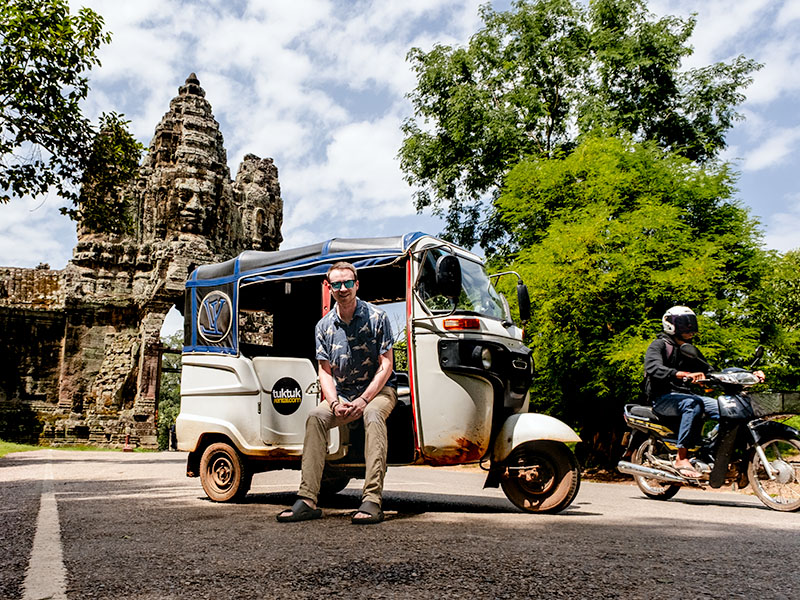We spent 3 weeks road-tripping around Cambodia in a tuktuk. Just the 2 of us, our bags tucked into the back, and a map that liked to lead us astray. It ended up being one of our all-time favourite travel experiences in over 4 years of travelling. As it’s a relatively new option, most people don’t even realise it’s possible to rent a tuktuk in Cambodia, let alone legal, safe, and ridiculously fun. So you’re already ahead of the curve on this adventurous experience. We’ve put together this no-fluff guide to answer all your questions on how to do it, what it costs, and why this might just be the best way to explore the country.
In short
- TukTuk Renal are the MVP of renting a tuktuk in Cambodia
- Costs between $18 and 22 per day
- You need a 1949 International Driving Permit
- Comfortably seats 3 adults (or 2 adults/2 children) plus 3 medium sized bags
Save 5% when you book through our exclusive link
Where to rent a tuktuk in Cambodia
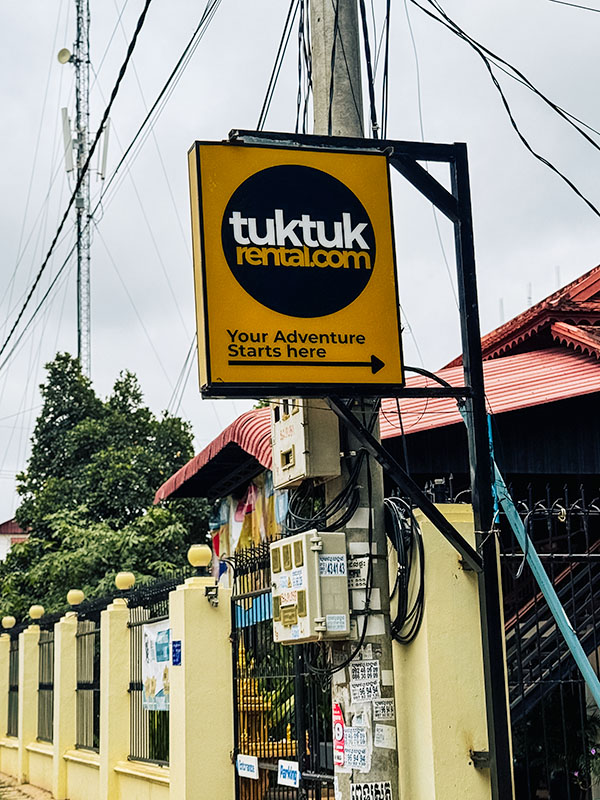
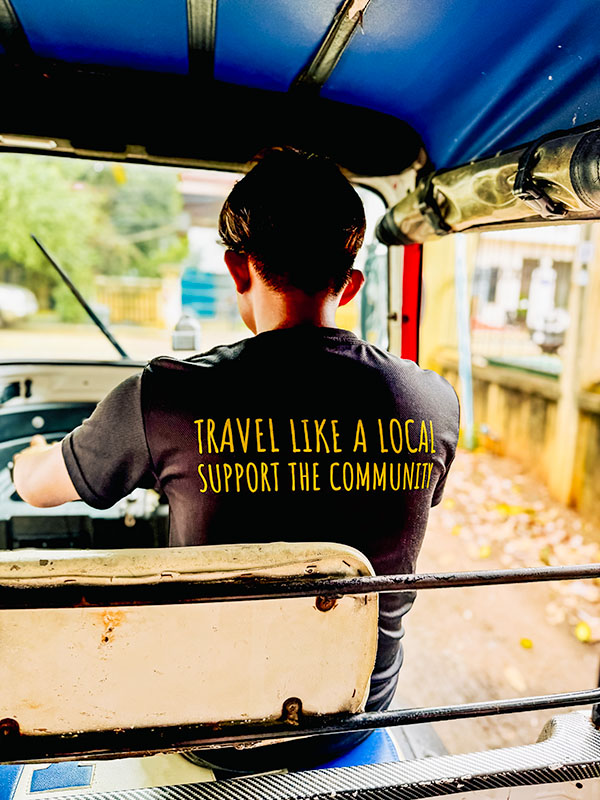
There’s only one company we recommend if you want to self-drive a tuktuk in Cambodia: Tuktuk Rental.
They’re based in Siem Reap, about a 10-15 minute walk from the Old Market. However, it’s possible to rent a tuktuk from them almost anywhere in Cambodia. But there’s a fee to transport the tuktuk from their office to your city of choice so you’re probably best doing what we did – a round-trip from Siem Reap.
There are three reasons we hired from Tuktuk Rental:
Firstly, we’ve rented from them twice in Sri Lanka back in 2022 and again in 2025. Both times, we had an amazing experience on month long road trips. As they hire locals, their local knowledge and support make them a perfect choice for anyone who wants to explore further afield in Cambodia. They even offer a free planning call to help you nail your itinerary.
Secondly, they’re a social enterprise. All the tuktuks are owned by local Cambodians and hired out by Tuktuk Rental so you’re putting money directly into the pockets of local people.
The third reason is probably the most critical… they’re basically the only company offering this in a way that’s useful for a full adventure in Cambodia. A local might rent you their tuktuk for a few days. But not one you can take out of the area to galavant across the country exploring its diverse landscapes.
Cost of renting a tuktuk in Cambodia
It’s surprisingly good value. Here’s the full breakdown including fuel, repairs and a few sneaky extras to budget for.
Rental cost
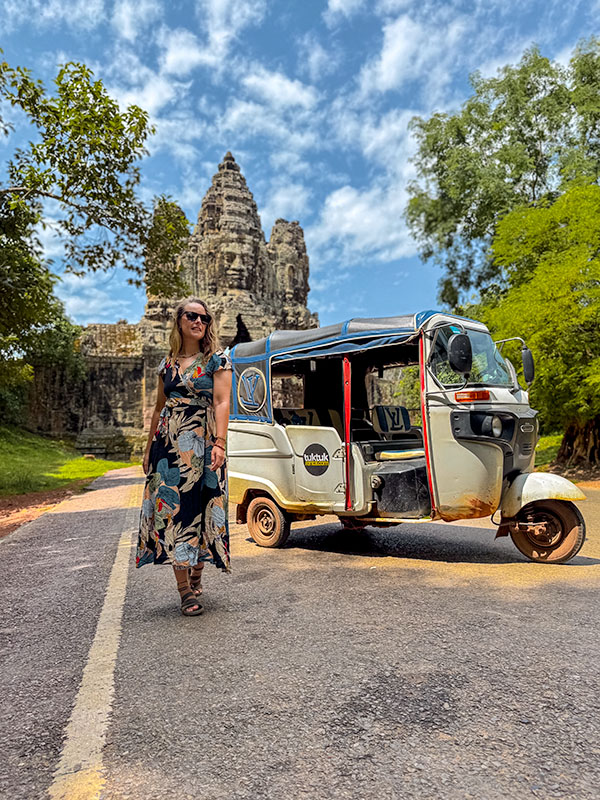
The daily rental cost depends on how long you rent your tuktuk for – you get a better rate for long term rentals, as you’d expect. Currently it’s between $18-22 per day (orrr if you book through our link, you automatically get a 5% discount.)
To put that into context:
- Scooter rental starts at around $10 per day
- Motorcycle rental is anywhere from $15 to 30 depending on the type of bike
- Car rental in Cambodia starts at around $40 per day
- Hiring a driver plus tuktuk to visit Angkor Wat starts around $25 for the day
So it’s pretty good value. While it’s much more expensive than a scooter, it’s also larger, more comfortable (especially for the passenger princess), better suited to longer journeys, fits more stuff, and is safer. For us, that makes it a no-brainer.
Fuel and maintenance costs
In Cambodia, tuktuks run on LPG, not petrol/gas.
LPG costs around $0.50 per litre and filling up your tuktuk costs around $5, if you run it to basically empty (not advisable). A full tank gets you around 150-200km range, depending on terrain.
We drove a total of 3,241km in our 3 week road trip and spent $60 on fuel. So it worked out at less than $2 per 100 km for us. Extremely cheap.
As all the important bits of a tuktuk are pretty exposed, there’s some other maintenance things you need to consider to keep it from breaking down on you. (Tuktuk Rental explain all this when you pick it up, so don’t panic if you’re as non-mechanically minded as us!)
You need to check the oil daily and occasionally top up, as it will slowly burn as you drive. Fully topping up the oil takes 1l which costs around $5. You need to buy the correct oil, so take a picture when Tuktuk Rental show you which one but most places that sell tuktuk oil will know what you need, if you forget. We spent $11 on oil in our 3 weeks.
Every 1000km you also need to take your tuktuk for “rubber greasing” – lubrication of the back axel. It takes around 45 mins for the mechanic to do and costs $5-10 per time depending on something mechanical we don’t understand. We needed to get ours greased 3 times for a total of $24.
So our total fuel and maintenance costs for 3 weeks and over 3000km were $95 or $3 per 100km.
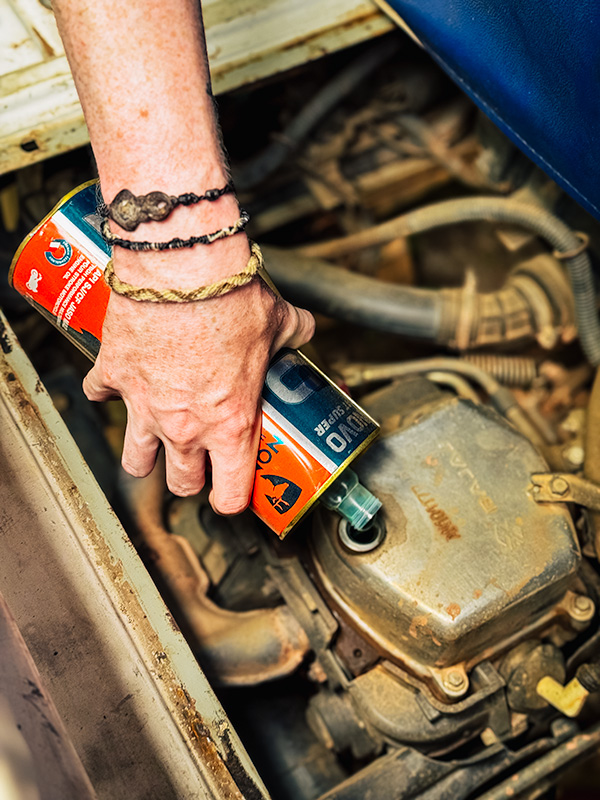
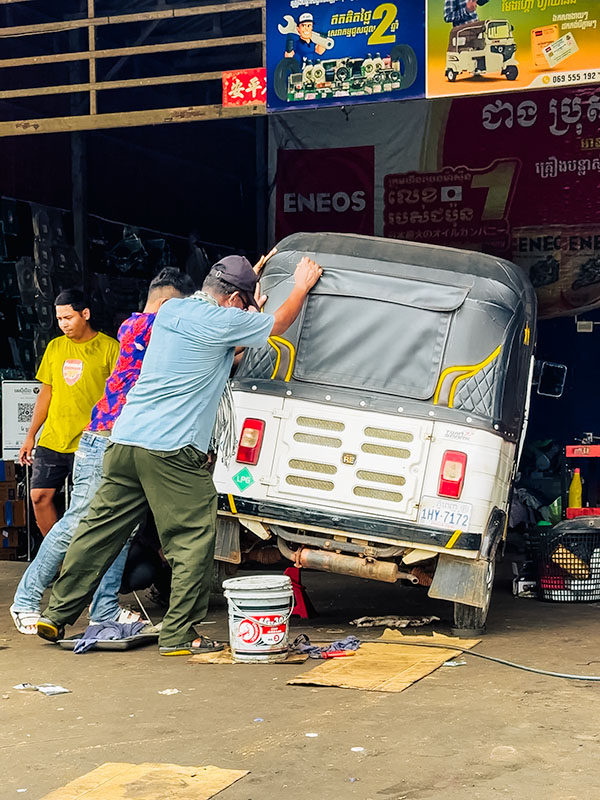
Deposit, insurance, and extras
Deposit
When you book your tuktuk with Tuktuk Rental, you’ll need to pay a $150 deposit by card as they’re a fully cashless company. This will be returned in full, assuming you return your tuktuk with no issues. We bounced ours around some pretty intense roads and had it completely covered in mud, and our full deposit was returned to us.
If you do manage to damage the bodywork, they won’t charge you the full amount to fix it. On our first tuktuk adventure in Sri Lanka, I took a chunk out the side of ours on our last day and they charged just a small amount that essentially goes into a repairs kitty that they’ll use to replace the whole part when it gets too damaged. This spreads the cost of bumps across many renters and lowers the price for everyone.
It also means your tuktuk may come with dents and scratches, so take photos/video before leaving.
Our deposit was back in our account 2 days after handing back the tuktuk, though it may take longer depending on your bank or if there’s any charges you need to pay.
Insurance
Tuktuk Rental include fully comprehensive insurance that covers the tuktuk and other vehicles in case of an accident. It also covers you and any others for treatment at a local hospital, but not a private one.
So even if you manage to write off your tuktuk, the $150 deposit is the maximum you’ll pay for vehicle damage.
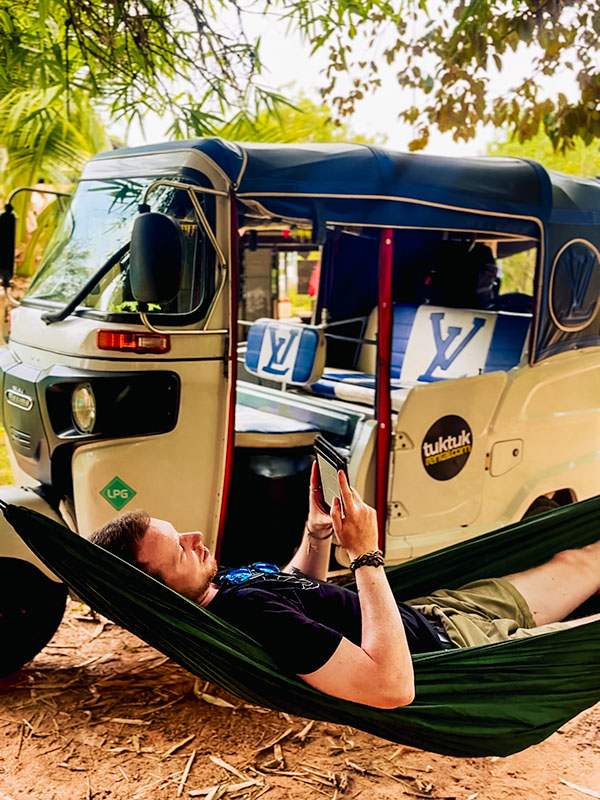
Travel insurance
Make sure you have your own travel insurance too.
Local hospitals in Cambodia unfortunately don’t have the best facilities, and if, God forbid, you are in a serious accident, you’ll likely need to be airlifted to Thailand for treatment. You don’t want to find yourself having to foot the bill for that ride, or worse, not being able to get to a doctor because you’re not insured.
I know we sound like your mother, but it’s never worth travelling without comprehensive travel insurance. Just make sure that your policy covers tuktuks as they’re not exactly usual vehicles to be driving. We use SafetyWing as our go-to insurer but we need to have the ‘Adventure Sports Add-on’ to actually be covered whilst driving a tuktuk. For us, that pushes the premium up by $10 for four weeks.
Extras
Tuktuk rental offer some optional extras to make your tuktuk adventure more enjoyable. These include a baby seat, bluetooth speaker, or cooler. They all cost $1 per day extra if you need any of them.
What you need to know
Before you start driving a tuktuk around Cambodia, there’s a few things you need to know and be prepared for.
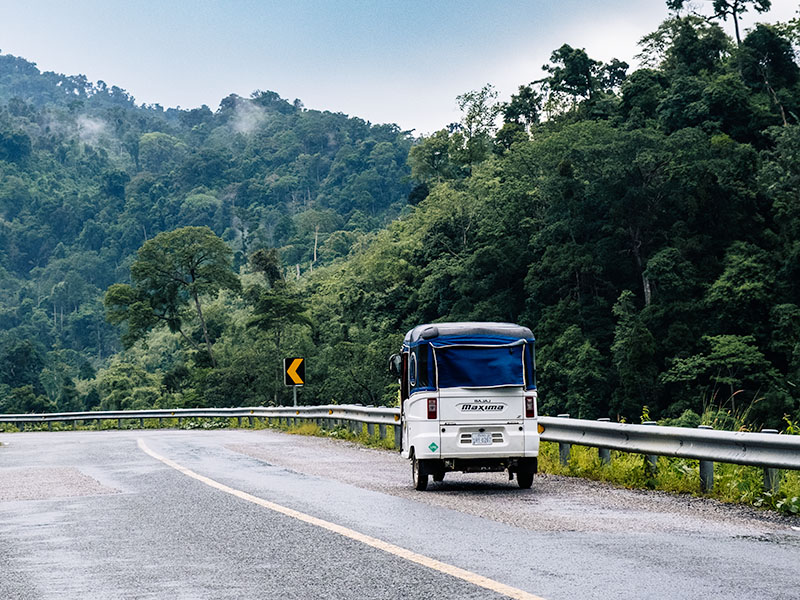
Is it difficult?
Driving a tuktuk in Cambodia is a lot easier than you might think. Anyone who has driven a manual car before should have no problem adjusting to the handle bar gear shift and clutch. Even if you haven’t, it won’t take much practice to get used to.
Before you set off, Tuktuk Rental give you a driving lesson around Siem Reap. It’s a bit intense at first to be dropped straight onto the road with other vehicles around but they go slowly to make sure you’re comfortable. They’ll cover how to start, change gear and, most importantly, how to stop! Which is a lot more than any scooter rental place will do.
The first time we drove one in Sri Lanka, it took less than 30 minutes for Matt to feel confident as the main driver. I’m a more nervous driver (even of cars on roads in my home town) so it took me a little longer but aside from in the main hub of the cities, I still feel good about driving it by myself.
The roads in Cambodia are considerably calmer than the roads of Vietnam and Thailand. This might not be so comforting if you’ve not spent time in those places, but I’d also say they’re calmer than many of the roads in Italy or Greece too. Being Scottish, we had to get used to driving on the right but other than that, you can just tuck yourself right into the side of the road and take your time.
Road conditions
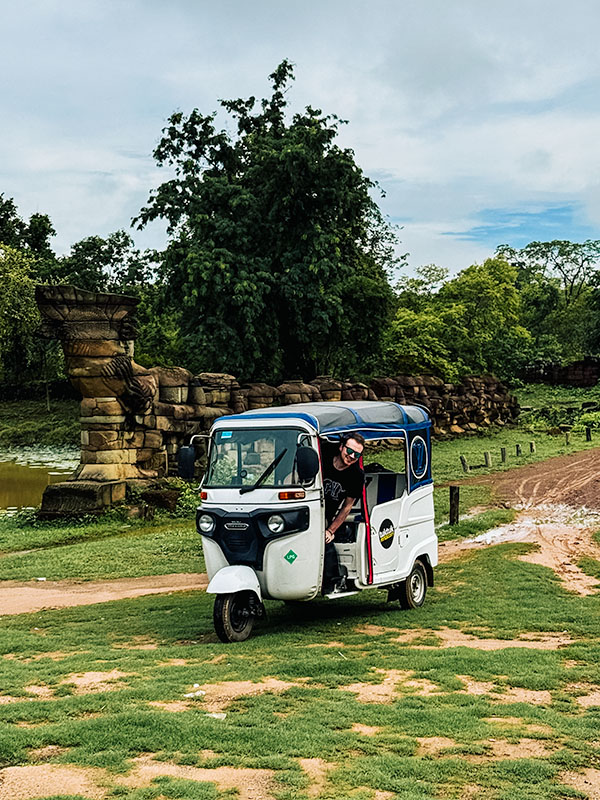

Most of the roads in Cambodia are pretty good. There’s a network of recently built, very wide highways that connect the major cities in the centre of the country. These roads do have a lot of trucks, buses, and other large vehicles that like to overtake each other but are also so wide that you could drive 3 of them abreast without issues.
Once you leave these newer roads most are still tarmac or concrete, if a little bumpier and narrower.
It’s only once you start to get away from the major routes, into the Cardamom Mountains or out to the very east of the country that you can find yourself on mostly dusty/ muddy roads and some very very bumpy ones. But if you take it slow, it’s no problem for your tuktuk to handle. That said, if you’re a sports bra wearer, make sure to pack it to keep the girlies from going off on their own adventure!
We found ourselves on some very “exciting” roads as we drove around Banlung in search of some temples hidden in the forest. Thankfully these were the minority since we ended up so covered in dust, I’m not sure we’ll ever be clean again.
Roads can be muddy and challenging during wet season (May–October), so dry season (Nov–April) is easier for first-timers.
Rules of the road
The main thing to know is the speed limits:
- 30 km/h in urban areas
- 80 km/h on rural roads
- and often 100 km/h on highways, though there may be signs telling you lower speed limits like if you’re near a school
If you’re wondering whether a tuktuk can even drive at 90 km/h, it can’t. Not without a wish, a prayer, and a very steep downhill.
The fastest I was happy to drive our tuktuk was 60 km/h, and even then only on the big, wide, flat highways. Realistically you’ll spend most of your time driving between 40-50 km/h so plan your routes accordingly as this is much slower than car driving directions will use to calculate your route time.
Outside of the speed limit, driving on the right, and obeying traffic lights, there isn’t really anything to worry about. Obey road signs like “no U-turns” etc but this is Southeast Asia and road rules are more like guidelines as far as locals are concerned, though we’re certainly not encouraging you to break the law.
If someone is flashing their lights at you, it’s usually to let you know they’re driving on your side of the road and have no intentions of slowing down. So you need to pull further into the hard shoulder or slow down to give them space to finish overtaking.
Navigation tips
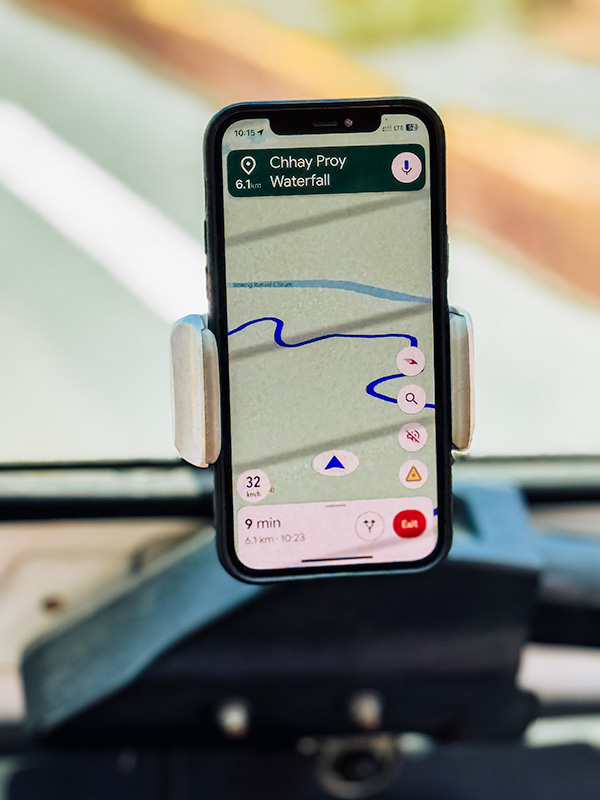
Google Maps will, mostly, take you the correct route.
The road network is still being built in the more rural areas so it might not always know that a road exists, or it may think one exists that doesn’t. If you’re trying to get somewhere, stick to the largest roads you can for as long as you can just incase.
We also had a few occasions where it wanted to divert us off straight main roads onto dusty paths before bringing us back to the main road. So we had to use our judgement and ignore it a few times, which always worked out fine for us.
Always download the map for offline use as signal will abandon you at times. If you end up somewhere that Google thinks there’s a road when there isn’t one, you might need to spend some time using Google maps like an old school paper map to find your way around. It tried to take us over a pedestrian suspension bridge barely wide enough for a motorbike… so be prepared for a little extra manual navigation.
Calculating travel times
Do not trust the travel times stated on Google Maps. It thinks you’re in a car and can drive at 80-90 km/h on the highways. I found it more useful to divide the distance by 50 to get a rough travel time that was closer to reality. Especially if you’re heading into the mountains or anywhere more rural where the roads won’t be as good.
Ultimately, when you rent a tuktuk in Cambodia, the journey is part of the experience. So just enjoy the views at your slow, leisurely pace.
Refuelling your tuktuk
In Cambodia, tuktuks run off LPG. And unfortunately, LPG isn’t everywhere in the same way that petrol/gasoline is. People sell petrol in glass bottles from small shops for example, so a little more planning is needed.
Tuktuk Rental provide you with their own Google Map with all sorts of tourist sites, hotels, viewpoints etc on it. But where their map really excels is having LPG stations and verified tuktuk mechanics on it.
However, we found that not every LPG station on the map was necessarily open and selling LPG when we got there. So it’s best not to rely on 1 specific station to refuel. Saying that, we never had an issue where we were worried about running out of fuel so with just a little planning, you’ll be fine.
The range is 200km so for most routes, you’ll be absolutely fine to find an LPG station especially if you’re in cities. We drove from Mondulkiri to Banlung and were pre-warned that there wouldn’t be anywhere we could stop on the 190km route for LPG but even then we were totally fine.
At the station, there’s always an attendant to refuel for you and you can either give them a specific amount or just say “full”. We only found one station where saying “full” in English was confusing but Google translate sorted us out. Large petrol stations on highways are also good places to break larger denomination notes if you have them and find a public toilet.
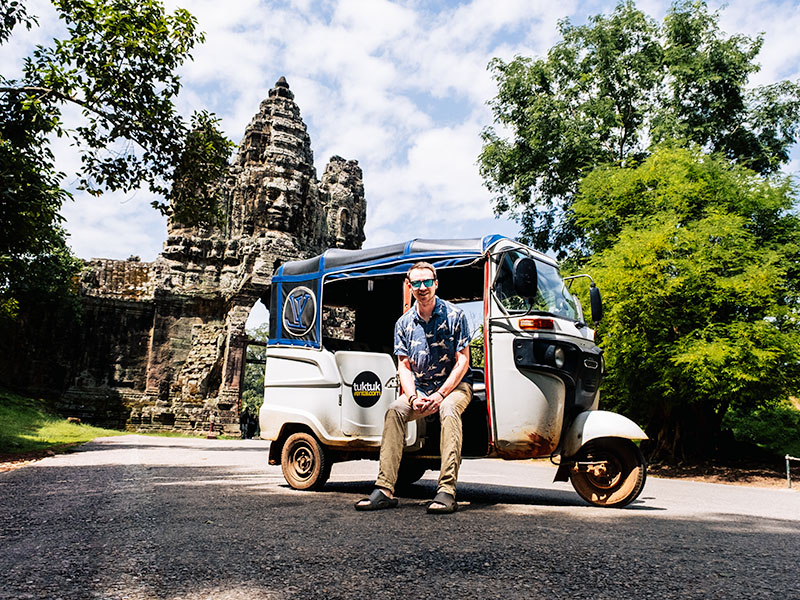
Breakdown support and mechanics
Tuktuks are still relatively new in Cambodia so the number of tuktuk mechanics is quite low, especially compared to Sri Lanka where they’re everywhere. There’s a fair few on Tuktuk Rental’s map though and, if you breakdown, there’s always someone at the end of a phone to help you out. Whether that’s getting towed to a mechanic or getting a replacement tuktuk to you. When we had an issue with getting ours greased, we gave them a call and they sorted us out in minutes.
We didn’t have any mechanical issues on our 3 weeks road trip, or in the months of driving one in Sri Lanka. But we did need to get our tuktuk greased a few times and this was a little tricky as the mechanics aren’t super common. Not enough to be an actual problem, we just had to plan a little more to make sure we were near one as we approached 1000km mark since the last greasing.
All this will improve over time as more Cambodian mechanics become accustomed to fixing tuktuks and more verified mechanics are added to the map.
Parking your tuktuk
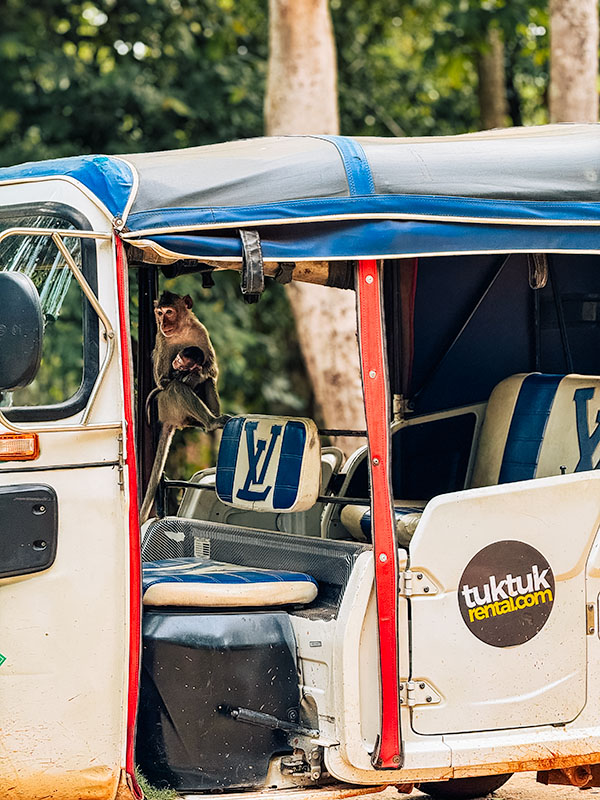
Parking is pretty easy. As long as you aren’t blocking someone’s house or business you’ll probably be fine to park at the side of the road for a little while at least. We always made sure our accommodation had parking which was mostly in a courtyard area. You’ll be guided as to where to park at most bigger tourist sites and some places, like around Angkor Thom, have no parking signs to stop the roads getting clogged up.
Always be wary of monkeys when you park up as they’ll steal anything not nailed down. They stole our phone holder but were generous enough to give it back by throwing it at my head – fortunately they have terrible aim! A friend of ours also had their cooler broken into and all their nicely chilled water stolen.
What licence do you need to drive a tuktuk in Cambodia?
You need to have a 1949 International Drivers Permit (IDP) along with your original license to drive a tuktuk in Cambodia. Tuktuks come under category B (cars) here so a motorcycle license isn’t required, or isn’t sufficient depending on how you look at it. You need to carry your home license and the IDP at all times incase you are stopped by the police and asked to provide them.
The 1949 IDP is only valid for 1 year and you have to obtain it in your home country before you leave. So if you’re travelling for a long time, make sure you don’t get caught out.
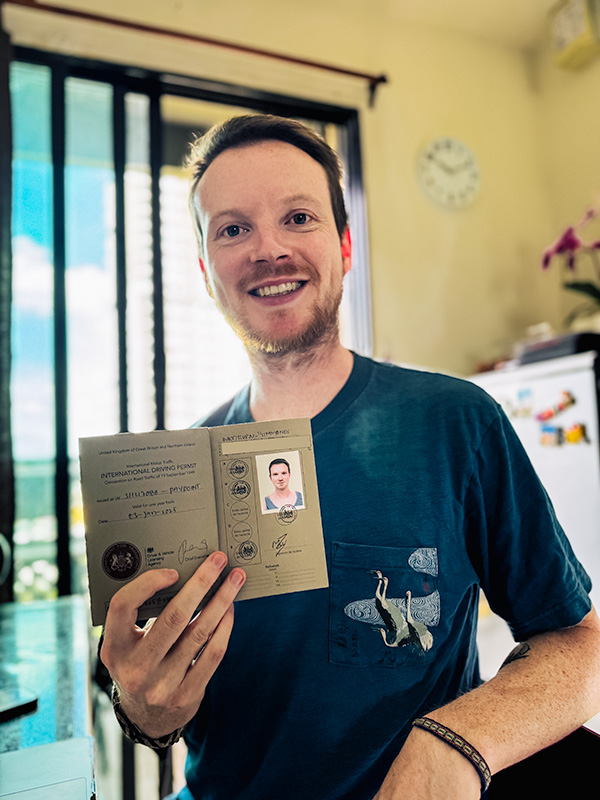
We both carried both licenses at all times (there’s no extra rental fee to have two drivers), but were never asked to show them. Tuktuk Rental won’t allow you to rent a tuktuk in Cambodia (or Sri Lanka) without the correct licenses, and your insurance would be invalid if you did.
Annoyingly the IDP is a flimsy paper document so we kept them in a waterproof cover in my trusty Uniqlo cross body bag so they didn’t fall victim to wet season.
You might see information online about it not being possible to rent a tuktuk (or any vehicle) in Cambodia but this is outdated info. In 2020, they changed the rules to accept the 1949 IDP.
Is it safe?
Driving in Cambodia might be a little different from what you’re used to. If you’ve driven in another Southeast Asian country before, you’ll probably think Cambodian roads are an absolute breeze. But if you’re coming from Europe or the US, it might freak you out at first.
Some things to be aware of:
- Locals don’t need a driving license if their engine size is less than 125cc – so a lot of scooters and motorcycles
- Motor insurance is only required for large commercial vehicles, so most people don’t have it (Tuktuk Rental DO fully insure their vehicles though)
- Lanes are more of a suggestion than a rule, with most road users just taking up all the available space and overtaking is really common
- Cows and dogs are frequent road users, especially outside the cities
- Cross roads often don’t have any traffic lights or stop signs – everyone just works off vibes and whoever got there first has the right of way
We don’t say any of that to freak you out and at no point did we ever feel unsafe on the roads. It might just take your mind a hot minute to get used to.
How big is a tuktuk?
It’s a lot more spacious in there than you might think.
How many people can you fit?
Okay so ‘can’ fit and ‘comfortably’ fit are not the same thing.
In theory, you could get 4 small-medium sized (by Western standards) adults in your tuktuk – 1 driving and 3 in the back. But it would be a tight squeeze and the engine might struggle going uphills. You’d have a bigger issue if you all also had luggage with you.
Honestly, we wouldn’t want any more than 3 adults (or 2 adults and 2 children) for a long road trip unless you’re on a tight budget and are all besties who don’t mind being almost on top of each other the whole time.
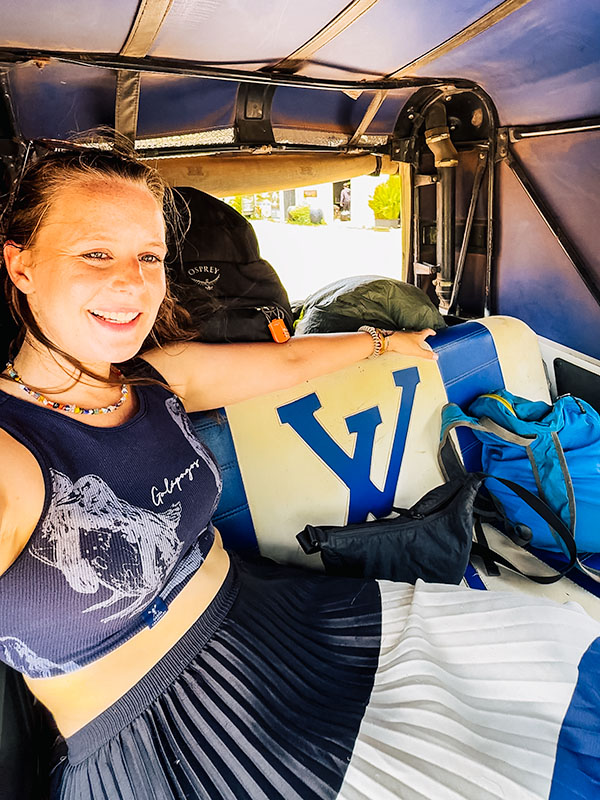

Space for bags
There’s a small ‘trunk’ section behind the back seat that you can put your bags in. We fit our 75L, 40L, and 25L Osprey bags with no issues – it was snug but that just meant they didn’t bounce around.
This area isn’t necessarily protected from the rain though. We had a fold down flap but it didn’t secure that well, so we always travelled with the rain covers on our bags just to be safe.
As this space is directly above the engine, it also gets quite hot. Not melt your bag or anything hot, but if you put drinks or food in the back they will be semi-cooked after driving quite far.
Tips for getting the most out of your tuktuk adventure
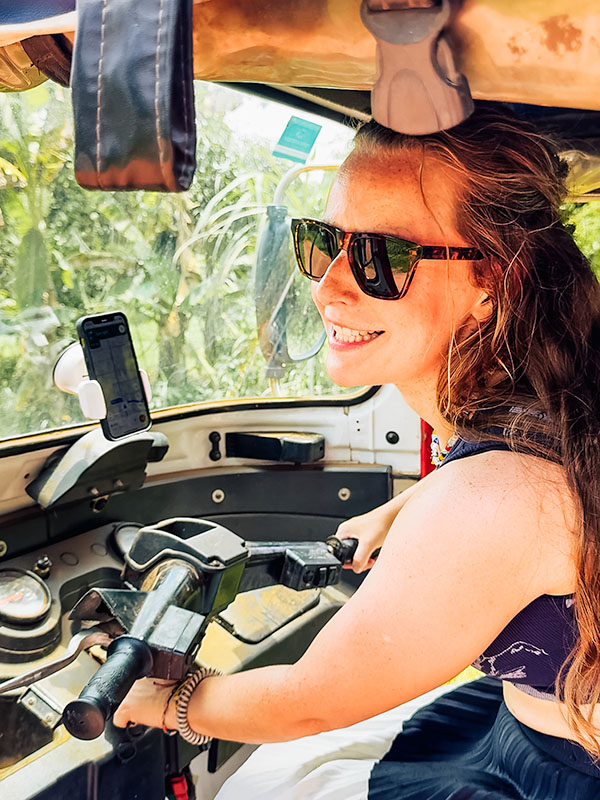
Planning an itinerary that hits up all the spots you want to see is the biggest first step. There’s jungle, beaches, forests and cities – so something for everyone. Make sure to plan it around what excites you most.
Then keep these tuktuk travel tips in mind:
Break-up long drives
Cambodia isn’t that big, but as tuktuks don’t drive that fast, and some roads aren’t the best, you can easily find a journey between two places will take 5 hours. This is the maximum Tuktuk Rental reccommends driving in a day, and with good reason.
It’s tiring to drive a tuktuk long distances. The vibrations up through the handlebars mean more effort is required than holding a car steering wheel and if the road is bumpy a lot more concentration is required, and strength to keep the wheels going in a straight line.
Always try and either split the driving or break up journeys by staying somewhere in between. Plan your route so you aren’t doing a 300km drive one day.
Bring a facemask
Some roads be DUSTY!
One day it looked like Matt had finally managed to get a tan… but it was just dust covering him from a couple of hours on a country road. LOOK AT THAT LINE THOUGH!!
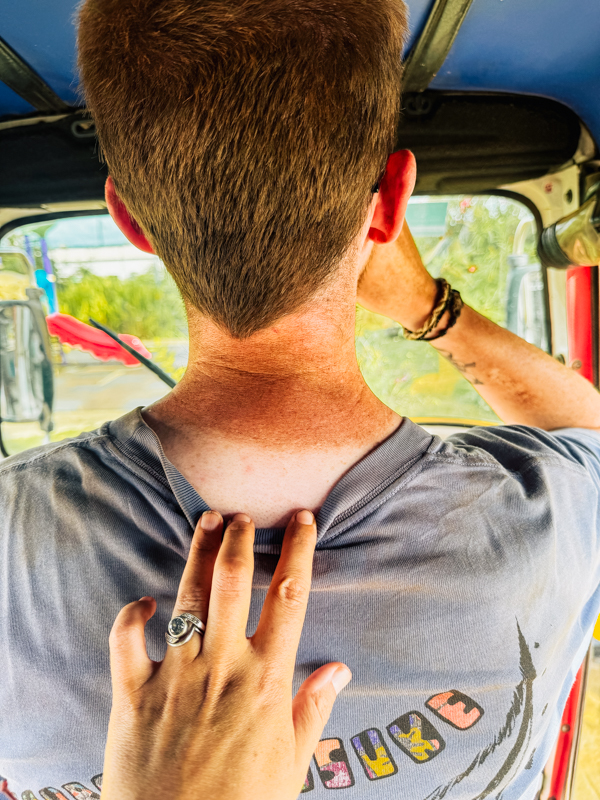
While the heat may discourage face mask use, you’ll soon feel congested with dust if you don’t wear one so we highly recommend it.
Take it slow
Your tuktuk can’t go very fast anyway. So hang out on the inside of every road, tootling along at your own pace and enjoying the scenery. Cambodia has some absolutely stunning landscapes and one of the best things about having your own tuktuk is being able to stop and enjoy them whenever you want.
Avoid driving at night
Whilst there are lights on a tuktuk, they’re not very powerful so driving at night isn’t advisable. We had to drive a little bit in a monsoon at 2am thanks to some ill-advised wet season camping, and could barely see 30m in front of us. Plus there’s always the possibility of drink driving from other road users, or dogs up to some nighttime shenanigans in the middle of the road.
So it’s best to park up for the night unless you absolutely have to.
Wait for storms to pass
You absolutely can drive in a tropical down pour – you can roll down the sides (rain flaps) of your tuktuk and stay pretty dry while doing it. But visibility isn’t the best and any tricky roads could become dangerous. We preferred to just park up and wait it out. It rarely rains at a biblical level for very long.
Dont try and drive “off road”
You’re driving a rear-wheel drive tricycle with a motorbike engine. No part of that is conducive to off-road performance. If a road looks too muddy, bumpy, or non-existent for you to ride a motorcycle down, you definitely won’t get your tuktuk down it. Thankfully we only had to push our tuktuk out the mud once. Would not recommend chancing it.
Going off road, even on foot, is generally not a great idea in Cambodia. There are still land mines across the country, many of which are known and cordoned off but they’re also still uncovering new ones.
Avoid rush hour in the cities if you can
The roads in Siem Reap and Phnom Penh never get really really bad, certainly not compared to those of neighbouring countries like Thailand or Vietnam. But driving in heavy traffic in a vehicle you aren’t super familiar with can be very stressful. So try not to unless you have to. And if you do have to, don’t stress if you stall a bunch of times, people will just drive around you.
Police stops and checkpoints
You’ll periodically see police checkpoints as you drive around. We were never stopped at one and to be honest, we’re not sure what they’re actually checking. Nor were we pulled over by the police during our trip. If you are stopped and have any issues, it is best to call Tuktuk Rental so they can speak to the police directly in Khmer and advise you on what to do

Should you rent a tuktuk?
Yes. Yes. YES!!
But if you need a little more convincing…
Pros
- Freedom to explore at your own pace
- More comfortable than a motorcycle or scooter
- More space for bags than motorcycle or scooter (we wrote a full tuktuk vs scooter comparison, here)
- Affordable
- Comes with trip planning call to help you find hidden gems and a custom map for your journey
- Easy to drive plus a free driving lesson
- A more local experience than hiring a car
Cons
- More expensive than taking buses/daily scooter rental
- It can take a while to get between places
Ready to make unforgettable memories in your own tuk-tuk?
Save 5% when you book through our exclusive link
Is a tuktuk right for your itinerary?
If you’re planning on hanging out in the southern islands of Cambodia, enjoying the beaches, bars, and sea, then no. A tuktuk is ideal for anyone looking to explore Cambodia beyond just the islands though.
Maybe if you’re on a really short itinerary, you won’t get the full value as you can hire a tuktuk with a driver for visiting Angkor Wat and a day tour is best to visit the Killing Fields and S21 Prison Museum in Phnom Penh.
But for 2 weeks or more of exploring Cambodia, a tuktuk is the ideal way to really experience the country with total freedom and without having to compromise on comfort (too much). Cambodia is best experienced with your own vehicle, something we learned on our second visit to the country after not having fallen in love with it the first time around. There is so much that is available to you, and riding in style in your tuktuk is way more fun than clinging onto the back of a scooter.
Cambodia
Browse all our guides here

